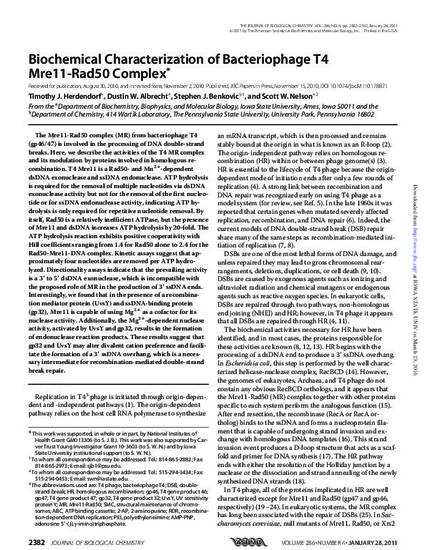
The Mre11-Rad50 complex (MR) from bacteriophage T4 (gp46/47) is involved in the processing of DNA double-strand breaks. Here, we describe the activities of the T4 MR complex and its modulation by proteins involved in homologous recombination. T4 Mre11 is a Rad50- and Mn2+-dependent dsDNA exonuclease and ssDNA endonuclease. ATP hydrolysis is required for the removal of multiple nucleotides via dsDNA exonuclease activity but not for the removal of the first nucleotide or for ssDNA endonuclease activity, indicating ATP hydrolysis is only required for repetitive nucleotide removal. By itself, Rad50 is a relatively inefficient ATPase, but the presence of Mre11 and dsDNA increases ATP hydrolysis by 20-fold. The ATP hydrolysis reaction exhibits positive cooperativity with Hill coefficients ranging from 1.4 for Rad50 alone to 2.4 for the Rad50-Mre11-DNA complex. Kinetic assays suggest that approximately four nucleotides are removed per ATP hydrolyzed. Directionality assays indicate that the prevailing activity is a 3′ to 5′ dsDNA exonuclease, which is incompatible with the proposed role of MR in the production of 3′ ssDNA ends. Interestingly, we found that in the presence of a recombination mediator protein (UvsY) and ssDNA-binding protein (gp32), Mre11 is capable of using Mg2+ as a cofactor for its nuclease activity. Additionally, the Mg2+-dependent nuclease activity, activated by UvsY and gp32, results in the formation of endonuclease reaction products. These results suggest that gp32 and UvsY may alter divalent cation preference and facilitate the formation of a 3′ ssDNA overhang, which is a necessary intermediate for recombination-mediated double-strand break repair.
Available at: http://works.bepress.com/scott-nelson/11/

This article is from Journal of Biological Chemistry 286 (2011): 2382, doi: 10.1074/jbc.M110.178871. Posted with permission.